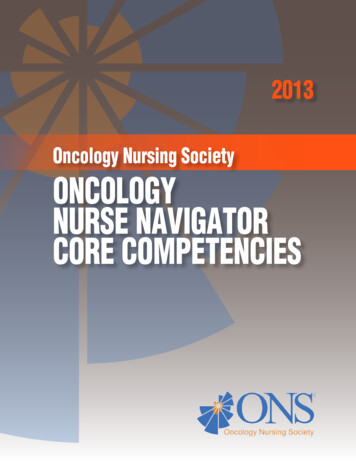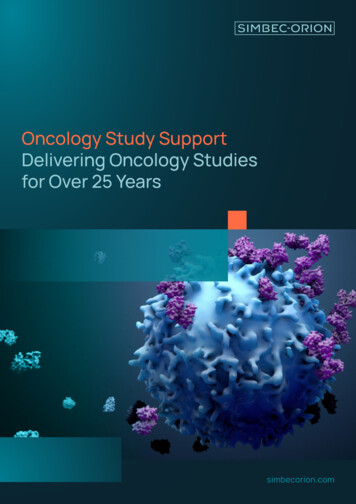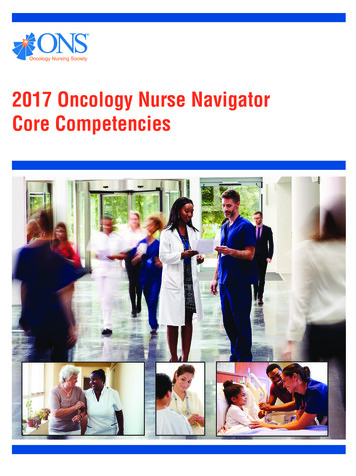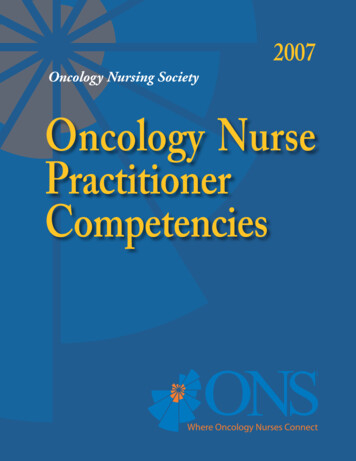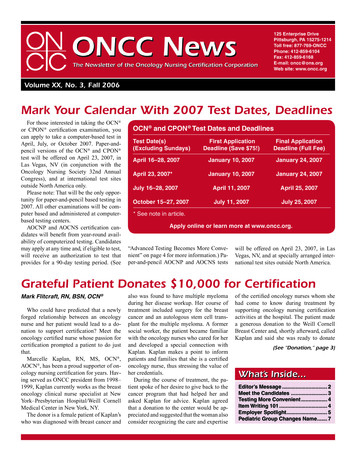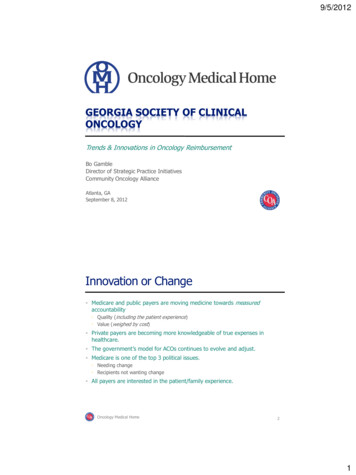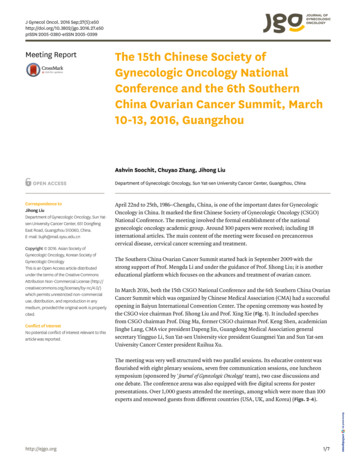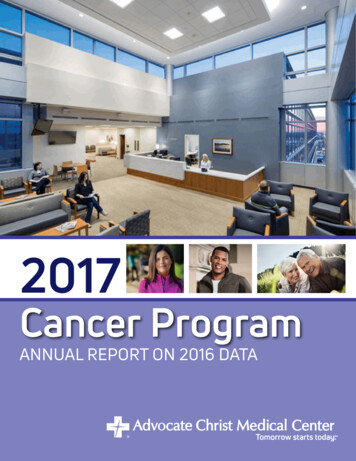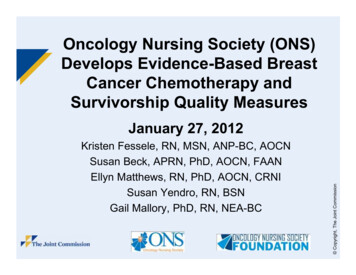
Transcription
Oncology Nursing Society (ONS)Develops Evidence-Based BreastCancer Chemotherapy andSurvivorship Quality MeasuresKristen Fessele, RN, MSN, ANP-BC, AOCNSusan Beck, APRN, PhD, AOCN, FAANEllyn Matthews, RN, PhD, AOCN, CRNISusan Yendro, RN, BSNGail Mallory, PhD, RN, NEA-BC Copyright, The Joint CommissionJanuary 27, 2012
Evidence-based practice (EBP) is afocus across all ONS activities Care practices on both the organizationand clinician level must be guided bythe highest-level of evidence available Evidence syntheses, clinical practiceguidelines, comparative effectivenessresearch tell us what to do, but2Clancy, 20092 Copyright, The Joint CommissionProject Background
3 Copyright, The Joint CommissionHow well do cliniciansimplement theevidence where itmatters?
Ideally, a good quality measure is derivedfrom a strong evidence base Focuses on a high-volume, high-impactprocess or outcome Is one that lends itself to a clear method ofmeasurement4 Copyright, The Joint CommissionHow well does everyone implement theevidence where it matters?
Project Overview– Develop and test quality measures– Facilitate incorporation of measures intoexisting quality measurement databases– Provide education on quality and qualitymeasurement5 Copyright, The Joint Commission The Oncology Nursing SocietyFoundation (ONSF) received a 3 yeargrant from the National PhilanthropicTrust’s Breast Cancer Fund
Measure Sets Developed and tested withThe Joint Commission’s Dept. of QualityMeasurement Based on ONS PEP resources and other sources Breast Cancer Care (BCC)– Focus on the care of patients receivingchemotherapy for breast cancer Survivorship Quality Measures (BCS)– Focus on the first year post-completion oftreatment for early-stage breast cancer Visit www.ons.org/Research/Quality for more info
Breast Cancer Care (BCC) Pre-treatment assessment– Fatigue, Distress and Sleep-Wake Disturbance Continuing assessment– Same problems, assessed every cycle Intervention for clinically significant level of Distress orSleep-Wake Disturbance Exercise recommendation made prior to chemo start Assessment of antiemetic regimen control Hand washing and fever level to contact practice CSF prescribed for admin. 24-48h after myelosuppressivechemo7 Copyright, The Joint Commission– Before cycle 2 moderate to highly emetogenic chemo
Breast Cancer Survivorship (BCS) Continued assessment of disease and treatment-relatedsymptoms Interventions for clinically significant issues with assessedsymptoms Education regarding:––––Diet and exerciseS/S to report to providerResources available in the local communityLymphedema risk reduction practices Individualized goal setting and attainment, with evidence of patientand family involvement (OUTCOME) Individualized follow up care recommendations for:– Bone density, breast imaging, LVEF monitoring, and pelvic exams where indicated Improvement of fatigue and distress scores over end-of-treatmentbaseline at 1 year follow up (OUTCOME)
Purpose of Pilot Testing Refine measure specification language tostand alone “on the shelf” Determine Reliability Determine Burden Relative to MeasureSet Implementation99 Copyright, The Joint Commission– Measure Level– Individual Data Elements
Draft measures Approximately 18 month process From ONSF/TJC Perspective External IRB Non-Human Subjects Research From Local Site Perspective Quality ImprovementPublic commentRecruit pilot sitesBAA/DUA ProcessAlpha TestingTrainingData SubmissionReliability TestingAnalysis
Test Site Selection––––Practice sizeRegion (state)Type of practice (organization, ownership)Setting of Care (teaching/non-teaching, rural/suburban/urban)11 Copyright, The Joint Commission Wide geographic spread Mirror the universe of health careorganizations – “real world” Based on demographic characteristics
Alpha Testing Establishes “basic” content validity Small focus group meetings at 4 pilotsites– Review language for each measure andassociated data elements–What do you think this is really askingyou to find?–Where would you find it in your records?–How feasible would that be to do formultiple cases? Rank measures within set
Reliability Testing Re-abstraction site visits at 12 pilotsites Project staff abstract data on 20 cases– Adjudication software compares originallysubmitted data to staff collection– Mismatches immediately flagged– Staff interviews pilot site data collectors touncover cause; frequently due to unclearspecification language Data analysis provides adjustedscoring
Copyright, The Joint Commission14
Copyright, The Joint Commission15
Reliability Findings Good agreement on:– Demographics– Lack of exercise recommendations– Definition of distress– Lack of documentation of symptom intensity– Identification of myelosuppressive regimens– Need to evaluate all cycles in the continuingassessment measures (BCC-02)16 Copyright, The Joint Commission Most mismatches related to:
Selected BCC testing results– Charting by exception– SOAP note format– Symptom intensity not commonlydocumented17 Copyright, The Joint Commission Exercise not often recommended Sleep-Wake disturbance not commonlyassessed Symptom assessment by nursingvaries
18 Copyright, The Joint CommissionPilot Data Summary
19 Copyright, The Joint CommissionPilot Data Summary
Overall, measure set is meaningful Clarification of what distress includes, andhow it is measured in practice needed Clarification of which regimens areconsidered myelosuppressive More specific guidelines for exerciserecommendations More examples in Notes for Abstraction20 Copyright, The Joint CommissionPilot Site Feedback
Oncology Quality Collaborative (OQC) Implementation work group Community of Practice model First session of OQC limited to interestedBCC pilot site participants Focus on evidence-based practicechanges needed to increase QM scoring– Symptom Assessment– Exercise Recommendations21 Copyright, The Joint Commission– 15 sites opted in
Expansion Breast Cancer original focus indeference to funder Many measures easily applied to otherdisease states Opportunities to develop manyadditional sets based on existing strongevidence22 Copyright, The Joint Commission– National Philanthropic Trust’s BreastCancer Fund
Summary High-level evidence supports creation of meaningfulquality measures– How consistently are we implementing our bestknowledge? Nationally tested measures based on PEP resourcesallow benchmarking of nurse-sensitive interventionsacross diverse sites QM are one important link in a chain of evidencetranslation and implementation Nurses are well-positioned to drive “Patientcenteredness” and high-quality cancer care!
Partial List of Pilot Sites Central Vermont Medical Center; Mountainview Medical, Berlin, VTCR Wood Cancer Center, Glens Falls, NYThe Cancer Institute of New Jersey, New Brunswick, NJEdwards Cancer Centers, Napierville, ILFairfax Northern Virginia Hematology Oncology, Fairfax, VAFroedtert Hospital and the Medical College of WI, Milwaukee, WIGroup Health, Seattle, WALankenau Hospital, Wynnewood, PAMagee Womens Hospital of University of Pittsburgh Cancer Centers,Pittsburgh, PANorton Cancer Institute, Louisville, KYOur Lady of Bellefonte Hospital (The Women's Center), Ashland, KYSaint Joseph’s Hospital, Nashua, NHSeidman Cancer Center, Cleveland, OHUniversity Of Miami, Miami, FLSouthwestern Vermont Regional Cancer Center, Bennington, VT
Co-Authors/Team MembersEllyn Matthews, RN, PhD, AOCN, CRNIGail Mallory, PhD, RN, NEA-BCSusan Yendro, RN, BSN25 Copyright, The Joint CommissionSusan Beck, APRN, PhD,AOCN, FAAN
26 Copyright, The Joint CommissionQuestions?kfessele@ons.org
CR Wood Cancer Center, Glens Falls, NY The Cancer Institute of New Jersey, New Brunswick, NJ Edwards Cancer Centers, Napierville, IL Fairfax Northern Virginia Hematology Oncology, Fairfax, VA Froedtert Hospital and the Medical College of WI, Milwaukee, WI Group Health, Seattle, WA Lankenau Hospital, Wynnewood, PA Magee Womens Hospital of .
